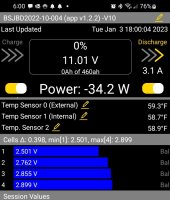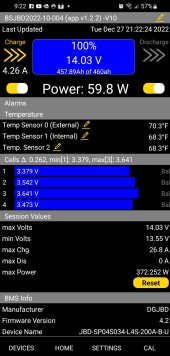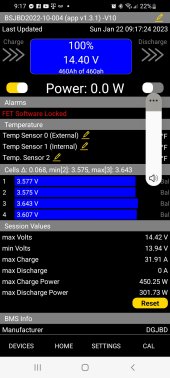John Frum
Tell me your problems
- Joined
- Nov 30, 2019
- Messages
- 15,233
Why ? There is no charge current flowing and the total capacity indicates 99% full .We can't tell from the second picture if your pack is balanced as all the cells are in the flat part of the curve.
Because all the cells are in the flat part of the curve.Why ? There is no charge current flowing and the total capacity indicates 99% full .
2023-01-22 05:05:32 Tail_current < 9A
2023-01-22 05:05:32 Boost=off Balance=10000010 Delta=0.039V Min=3.434V(cell1) Avg=3.452V Max=3.473V(cell0) Cell=26.6C Ambient=25.8C Rate=8.9A
2023-01-22 07:00:41 Power=off Balance=00000000 Delta=0.006V Min=3.336V(cell6) Avg=3.339V Max=3.342V(cell1) Cell=26.2C Ambient=25.6C Rate=0.0A


Opening the case and adding charge or load to individual cells is a very quick way to balanse a pre-built pack but there is still hope for those of us who have sealed, non-cervicable packs.
This is where I started. This is actually not the worse case given that this pack had been held at 13.9v for a week for balancing before I took this screen shot which was after the first full capacity test. I did not get a screen shot of the worst delta which was almost 300mv.
1/2/23
Bottom delta @ UVP = 398 mv
12/27/22
Top delta @ OVP = 262 mv
1/22/23
Top delta @ OVP = 68 mv
This is a huge increase in the balance of the pack. I did it by turning off charge balance and charging it slowly until cell #3 got to OVP cutoff. I then turned off both charge and discharge FETs and let the pack balance for 24-hours. rinse and repeat. I saw gains in the max pack voltage I could charge to and reduced delta each day.
I did not hold the pack on float. I charged it up and the isolated it from all charge and loads. The balancing was with charge balance "off".Yep. This is pretty much the standard way of doing it. Float the battery at the maximum voltage it can sustain without triggering BMS cut-off. A typical JBD/overkill can balance about 0.5-1.0Ah/day, so it may take awhile.
However, I'm a proponent of holding the cheap-os accountable. If the battery can't be charged to recommended voltage, it does not meet spec. They're using the customers as the final step for quality assurance. An as-received imbalanced battery means they are making no effort to match or balance cells, which means they're of lower quality and may indicate reduced service life.
I did not hold the pack on float. I charged it up and the isolated it from all charge and loads. The balancing was with charge balance "off".
I agree that it would be good do "hold the seller accountable" but given that it takes 2-months each way and I would need to pay for the shipping, for me, it was better to see if i could get the pack to balance and save the trouble. In the next week or so, I should have it balanced and able to charge to +14.5v and then will do another capacity test.
In the first test, this battery only gave 445Ah out of the rated 460Ah. The other more balanced pack (80mv @ OVP) gave me 475Ah so I am very confident that this pack will now exceed specifications.

That first weed I did float them at 13.9v but did not like having the constant high voltage with even the tiny charge current that went with it. During that time, I had charge balance turned off because most of the time, there was 0w going or coming from the Magnum, so I was not using the charger for anything other than holding steady at 13.9vYes, you want to turn charge-only balance off. The issue with not keeping a float voltage applied is that the slight current from the balancers often pulls the cell voltage down below the balancing threshold pretty quickly, so balancing stops.
I understand that there are other factors at play in the "return or salvage" decision. Important to procure from sources that provide free returns as a company sending you a product that does not meet specification is their issue, not yours.
How did you maintain 13.9V for a week if you didn't float it?
Had you continued to hold it at progressively higher voltages rather than the on/off approach, it would have balanced faster.
I would call that good and get on with life.So, i balanced it by putting a load on cell 3 and have them a little more equal now. But CMOS is still tripping once the cell voltage gets high enough. Makes me wonder if the charger (2Amp Noco) is actually going higher than 14.6 volts.
View attachment 131055
Well that's one way to make the time balancing pass faster, count it in terms of the doobies you burn through while doing it. ?That first weed I did float them at 13.9v but did not like having the constant high voltage with even the tiny charge current that went with it. During that time
They are always balanced there. Past 3.5Vpc or so usually bms will start balancing one.We can't tell from the second picture if your pack is balanced as all the cells are in the flat part of the curve.
It appears that you have your charging set to 14.6v which means that your pack needs to be perfectly top balanced to 3.65v and even then, will still shut down due to OVP. In normal charging conditions it is best to not charge that high. down around 14.2 - 14.4 is fine.So, i balanced it by putting a load on cell 3 and have them a little more equal now. But CMOS is still tripping once the cell voltage gets high enough. Makes me wonder if the charger (2Amp Noco) is actually going higher than 14.6 volts.
View attachment 131055
On one of my packs, I had a 300mv delta with cell #3 was at 3.65v. Even with that huge delta, the cells were all within 5mv when the battery was between 12.8v and 13.3v. After that, the delta would just go off the chart.They are always balanced there. Past 3.5Vpc or so usually bms will start balancing one.
To show balance at that voltage I would have to plug in and fire up the charger. RV is in storage mode, I just let the SCC trickle it and keep it around 3.30 to 3.35Vpc.
Perhaps in the next few days I'll capture cell state at high knee with the battery charger. Wouldn't hurt to exercise them a little. It's been sitting for months - last trip was first of October.
The old A123 ANR26650 M1 specification stated it but I'm having trouble finding a copy of the old datasheet. HKJ copied the info and put it on his websitePlease cite a LFP cell specification that permits this.
I know what you're saying, but it's old information, and it shouldn't be perpetuated.


